CNAP Trials Begin: Your Mobile Will Soon Reveal Real Caller Names
India is taking a bold step to combat spam and scam calls. The Department of Telecommunications (DoT) has launched trials for a new feature called Calling Name Presentation (CNAP). This service will display the real name of the caller—even if the number isn’t saved in your phone. Think of it as India’s own version of Truecaller, but backed by telecom operators and verified KYC data.
The CNAP feature is currently being tested in Haryana and Himachal Pradesh. If successful, it could be rolled out nationwide by March–April 2026, making it harder for fraudsters to hide behind fake identities.
What Is CNAP and Why Does It Matter?
CNAP stands for Calling Name Presentation. It’s a telecom-level feature that shows the registered name of the caller on your mobile screen during incoming calls. Unlike apps like Truecaller, which rely on crowdsourced data, CNAP pulls directly from the telecom provider’s verified KYC database.
This means:
- No more guessing who’s calling.
- No more fake names or impersonation.
- A major blow to spam, scam, and phishing calls.
Where Are CNAP Trials Happening?
The trials are currently live in:
- Haryana Circle: Reliance Jio, Vodafone Idea, and BSNL are conducting tests.
- Himachal Pradesh Circle: Bharti Airtel is leading the pilot.
During this phase, if a user receives a call from a number registered in these circles, the name linked to the SIM will appear—even if the number isn’t saved.
Phone pay also introduced special feature to prevent frauds. Read this article to know more : New PhonePe Feature Stops Fraud Before You Pay
How CNAP Will Help Curb Scams
India has seen a surge in scam calls—from fake bank alerts to impersonation frauds. CNAP aims to:
- Expose real identities of callers.
- Reduce impersonation by fraudsters.
- Empower users to avoid suspicious calls.
This is especially important in rural and semi-urban areas where digital literacy is still growing.
Will It Work on All Phones?
Not yet. CNAP will initially work only on:
- Smartphones with 4G/5G
- Mobile numbers (not landlines)
- SIMs with updated KYC
It won’t work on:
- 2G networks
- Landline numbers
- Feature phones (for now)
However, DoT officials have confirmed that landline integration is planned once data systems are aligned.
When Will CNAP Launch Nationwide?
If trials go smoothly, CNAP could be rolled out across India by March–April 2026. The DoT has urged telecom operators to fast-track implementation.
This means:
- Every mobile user in India could soon see the real name of every caller.
- No need to install third-party apps.
- A default feature on all phones.
What About Privacy?
CNAP uses the name provided during SIM registration. This raises some privacy concerns, especially for users who may not want their names displayed.
However:
- The DoT is considering opt-out options.
- Names will be shown only during calls, not stored or shared elsewhere.
- CNAP is regulated and verified, unlike crowdsourced apps.

Why This Matters for India
India has over 1.1 billion mobile subscribers. With rising digital adoption, phone scams have become a national nuisance. CNAP is a Made-in-India solution that:
- Boosts digital trust.
- Protects vulnerable users.
- Reduces financial fraud.
It’s a step toward a safer, more transparent telecom ecosystem.
📢 Final Thoughts
The CNAP rollout could be a game-changer for mobile users across India. With verified caller names appearing by default, spam and scam calls may finally meet their match.
Stay tuned as we track the rollout and share updates from the telecom circles.
📢 Follow us on Arattai and Telegram for instant news updates and exclusive stories!
👉 Join our Arattai Group – https://aratt.ai/@indiaworld_in
👉 Join our Telegram Channel – https://t.me/indiaworld_in
Absolutely! Here’s a reader-friendly, conversational FAQ section you can embed directly into your article. It’s optimized for readability, SEO, and engagement:
📚 Frequently Asked Questions (FAQs)
❓ What is CNAP?
CNAP stands for Calling Name Presentation. It’s a telecom feature that shows the registered name of the caller on your phone screen—even if the number isn’t saved. It helps users identify unknown callers and avoid spam or scam calls.
Is CNAP implemented in India?
Yes, CNAP trials have already begun in India. Telecom operators like Jio, Airtel, BSNL, and Vodafone Idea are testing the service in Haryana and Himachal Pradesh. A nationwide rollout is expected by March–April 2026.
What is CNAP in cybersecurity?
In cybersecurity, CNAP may refer to Continuous Network Assessment Protocol or similar frameworks. However, in the telecom context, CNAP refers to Calling Name Presentation—a caller ID verification system designed to reduce fraud and spam.
What is the full form of CNAP?
The full form of CNAP is Calling Name Presentation.
What are the benefits of CNAPP?
CNAPP stands for Cloud-Native Application Protection Platform. It’s a cybersecurity solution that protects cloud-native apps across development, deployment, and runtime. It helps detect vulnerabilities, enforce policies, and secure workloads.
Will *#21# tell me if my phone is tapped?
No, dialing *#21# only shows call forwarding settings. It does not indicate whether your phone is tapped. Detecting phone tapping requires specialized tools and legal procedures.
Which SIM offers free incoming calls?
Most Indian telecom providers offer free incoming calls on prepaid SIMs. Popular options include Jio, Airtel, BSNL, and Vi. Plans may vary by region, so check with your local provider.
Can scammer phone numbers be traced?
Yes, scammer numbers can be traced by telecom operators and law enforcement agencies. They use call records, SIM registration data, and location tracking to identify and investigate fraudulent activity.






